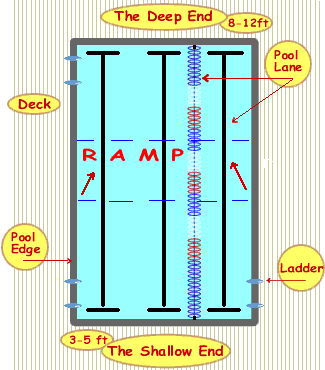Schools & Lessons: Deep end practice
Some of you have requested this, so I’m discussing treading water. With certain conditions attached for pool safety.
Treading in deep water is a survival technique taught in a pool’s deep end.
To know how to stop swimming in deep water, and then tread water, is necessary for your control, your confidence and your safety.
So, friends, if you can swim across a pool from the shallow to the deep end, this section is for you.
But before we proceed I’m laying down the rules.
I can provide information and advice about deep water skills.
I can also help you reduce your risks.
Obviously I won’t be teaching or supervising you at your pool.
It’s up to you and your common sense to choose your teacher and the safest conditions for your deep end practice.
Safest conditions for the deep end
Here’s what you must have before you start deep water practice:
- You’ll need your teacher, dedicated to you.
- A pool, public or private, with a shallow and deep end. There should be a sloping ramp angling down from the shallow to the deep end.
- Pick a quiet hour for practicing. No distractions.
- There will be a lifeguard watching the (public) pool. Request that the pool’s lane line nearest you be taken down. You’ll be glad of the extra room.
These are the minimum safety conditions you need for deep water practice.
Here’s what your public pool will generally look like:

A typical pool
(Pool depths vary depending on the pool)
Alrighty. You call up your teacher and get suited up. Let’s tread!
Bobbing first, then treading
… But first we’ll bob. Bobbing prepares you for rhythmic breathing in deeper water; it’s good for your confidence.
- You’ll need your teacher on the pool deck, preferably sitting at the edge, next to you.
- You are in the pool facing your teacher and the pool edge, standing at the top of the ramp.
- Your head is clear of the water and you are easily holding onto the pool edge.
- You’re going to slowly bob up and down, all the time holding on to the pool edge.
- Take a normal breath, bend your knees with your feet flat on the ramp, exhale everything through your nose as you lower yourself and your face into the water.
- Exhale everything, come back up and inhale. Nothing new here, you know how to bubble.
We’re going to gently repeat this a few more times.
Fully exhale your normal-sized breath through your nose and mouth. Nice and relaxed, with no leftover air.
Treading, face-down
OK, let’s tread.
- You can start at the top of the ramp. The water should be up to your chest, at least. (A gentle reminder that your buoyancy works best in deeper water. Buoyancy makes treading possible.) But, practice according to your comfort.
- As you did with bobbing, face the wall, hands on the pool edge, and let yourself hang in the water a bit. You may sink a little – that is normal.
- Your face should be submerged, with your mouth a little open, jaw relaxed.
- Hold your breath without bubbling it out this time.
- Raise your face for your next breath, exhale it all out and submerge again. Your whole body is relaxed, and you’re still holding on to the pool edge.
- Begin with a slow “giant stride” scissor kick. Slowly, please. No need to work hard while treading – this is a survival technique. Save your energy. Your ankles are relaxed as usual. Each kick pushes you upward.
- Now add a wide, ongoing breastroke-like sweep with your hands, first in front of you, palms out, pushing water behind you along the surface, then returning your hands to the front, palms facing as they meet in front of your chest… back and forth… it’s slow but powerful.
- You’ve pushed yourself a bit away from the wall to do this. Come back at your own pace.
- Keep submerging your face, breath held in your lungs (mouth a little open), raising it up only to take your next breath.
- Exhale all your air before inhaling again. Stay relaxed and curved a bit forward. Note that your air-filled lungs are the highest part of your body.
That’s it. You shouldn’t be too far from the wall and can swim easily back. Your teacher will be sitting right there at the pool edge with you, too.
Treading, breathing freely
As you become comfortable treading with your face down, you’ll then:
- lift your face up and back,
- looking up,
- leaning backward,
- as you rhythmically scissor and sweep.
- you only need your face clear of the water,
- your body relaxed and
- your movements remaining slow and steady.
You can adjust your stroking movements, of course, in order to gradually tread for longer and longer periods.
Good treading to you!


